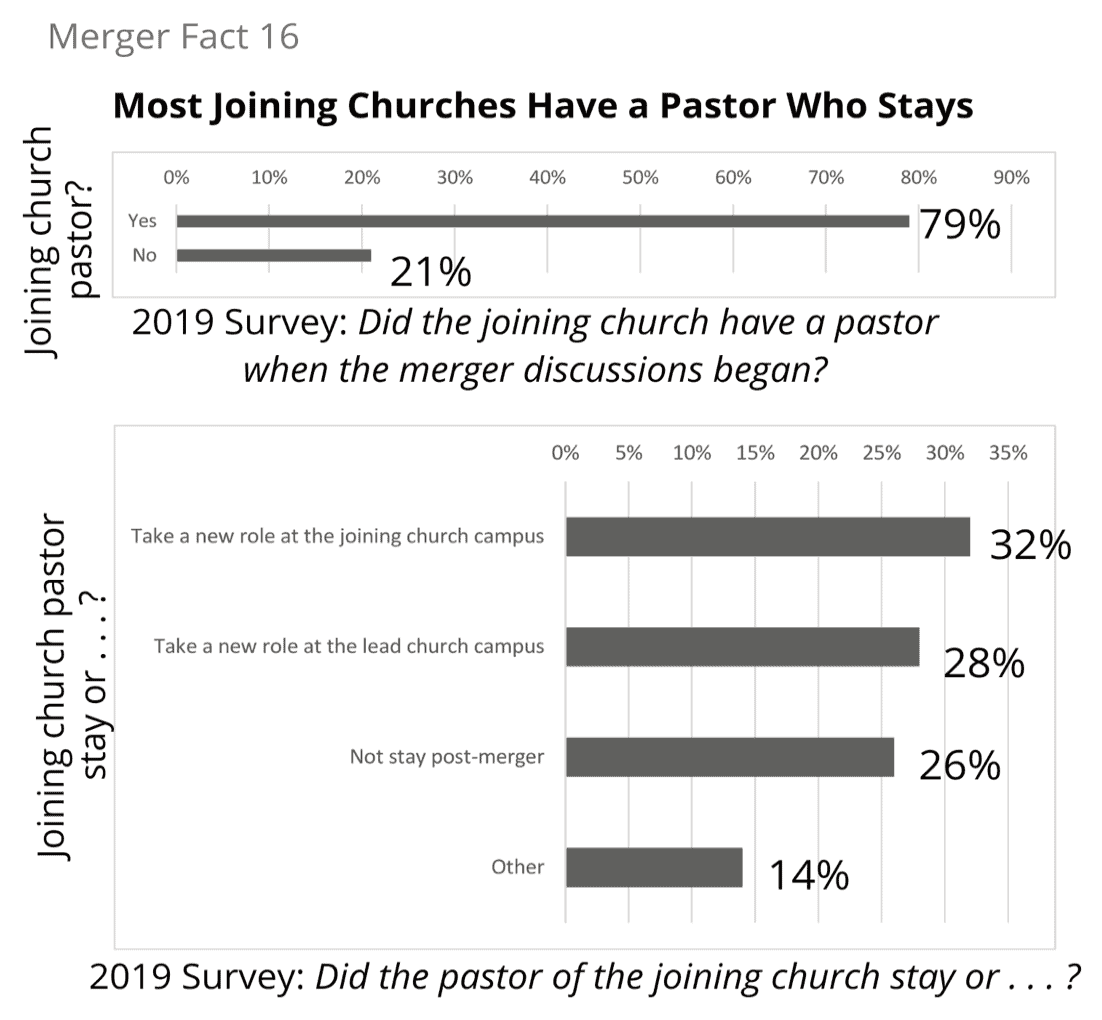“What will happen to me and others on church staff if we merge with your church?”
Staff transitions are one of the stickiest issues associated with a merger. In churches a change in staff is a delicate issue because of the relationship between staff and congregation. In addition, Christ-followers want to treat outgoing staff with honor, compassion, and when possible, generosity.
Almost every church has someone on a payroll, even if only part time. The most common roles to work through in mergers are that of pastor, secretary or equivalent, worship leader, youth worker, child care workers and custodian. The larger the church, the more paid staff to deal with in most cases.

Senior Pastor Transitions
The most visible and delicate staff role to discuss in a merger transition is that of the joining church pastor. “What will happen to our pastor?” is the first question to address in the merger conversation.
From our consulting experience and research behind the book Better Together: Making Church Mergers Work, expanded and updated edition, co-author Warren Bird and I see four possible pathways.
1. No Pastor at the Joining Church
Though the majority of church mergers involve two lead or senior pastors (79%), our recent research also reveals that a growing number of churches (21%) are filling the lead pastor role through a church merger (see Merger Fact 16).
This is happening more because there is a growing shortage of pastors on the horizon. The majority of churches today are pastored by aging Baby Boomers who are approaching retirement within a decade with a smaller number of Next Gen pastoral candidates available.
In addition the typical cross-country search for a new pastor is fraught with many uncertainties and risks. Will the new pastor from out-of-town fit culturally with our community? Will the pastor’s spouse and family be happy in our community? What kind of changes will the new pastor bring? These unknowns are greatly reduced in merging with a locally known and proven pastor with a good track record.

2. The Joining Pastor Departs after Merger Is Approved
Sometimes no staff position is available with the lead church. Other times the joining pastor is retiring or desires a ministry/career change and is not interested in staying post-merger. Sometimes the joining pastor is financially supported through a new ministry role/endeavor by the lead church.
Regardless of the various reasons for not staying, the pastor’s departure is a delicate situation that needs to be handled well. When a pastor decides not to remain, a joining congregation can feel a sense of rejection from its “beloved” pastor, and good will can turn sour toward the lead church. Resentment can also build toward the lead church if it does not retain the joining church pastor in some form of staff role. Departing pastors hold the key to shepherding their congregations with loving reassurance through this transition.
In all of these situations it is wise to offer a generous severance package and a happy farewell to the departing pastor. A good departure will help produce a better merger outcome for both congregations.
3. The Joining Pastor Becomes Staff at the Lead Church
This is the most common option, even if it lasts only for a season, in order to allow the joining church’s pastor to depart graciously, and it invites a smoother transition.
Such arrangements can be spelled out as part of the merger negotiations. For example, the lead church can say, “Both congregations will understand that you’ll continue in your current role as the pastor up to the decision to merge, then we will reposition you somewhere else on our team or release you with a generous severance package.”
Sometimes the merger arrangements envision more than a transitional role for the pastor from the joining church. As Merger Fact 16 above demonstrates, the majority of joining church pastors continued post-merger in a staff role but very few as the lead pastor, co-pastor, or campus pastor. The one exception is when the joining church pastor might become the senior associate pastor and eventual successor to the lead pastor.
The most common roles we hear about are associate pastor, pastoral-care pastor, small-groups pastor, adult ministries pastor, or missions pastor. The most important success factor is that it is a good fit for the person’s strengths and ministry passions.
4. Pastors Become Co-Pastors
True co-pastoring rarely occurs and for good reason: they rarely succeed because it is hard for two heads to lead together. Sometimes a co-pastor merger does occur in a church merger as part of a succession plan for one of the pastors.
Most often co-pastorates tend to happen in smaller churches, compounding the financial problems the churches were facing as they went into the merger. Even if the finances were not problematic, we still do not recommend this option for mergers, and have not seen a healthy, growing model of co-pastors from merged churches. (We have seen the rare successful co-pastorate that was unrelated to a merger, however.)
Co-pastorates tend not to work, we suspect, because it’s too hard for two different church cultures to come together under the umbrella of sharing the best of both worlds, arbitrated by two people who are trying to be equal with each other. As we’ve said before, merging is like dancing: one person needs to lead, and the other to follow.
Staff Member Transitions
What about the other staff members in the joining church? They are often the ones most fearful of a merger and for good reason—their job security is at risk and their future is the most uncertain.
Typically, the options for the joining church staff are to continue in their current role, accept another role, or be released with a severance package. Here’s some general advice for staff transitions:
Avoid sweeping promises such as “We’ll keep all staff.”
Numerous people told us that they wish they hadn’t made the promise because if staff didn’t fit the new culture of the merged church, it was more difficult to help them move to a different place of employment. Promises like that also invite people to take sides: “You didn’t keep your promise” or “That’s yet another change and loss for us.”
A better approach is to put in writing that the merger process offers no guarantees or promises of ongoing employment. Something like, “Staff of the joining church may be asked to continue to serve in the same capacity or could be redeployed to another area based on need, compatibility, and skill set. Staff not retained or who desire not to remain will be offered appropriate severance.”
Retain any staff that are genuinely needed and can be afforded.
The more clarity the lead church has on its mission and strategy, the easier it is to determine what staff are needed and wanted.
Extend an invitation to all staff to apply for any open staff positions.
Every staff member from the joining church is invited to apply for their current position or another role in the merged church.
Offer generous severance packages relative to how long they’ve served.
Some staff at the joining church see this as an opportunity to transition off staff with honor, dignity and a generous severance.
A Final Thought to Transitioning Senior Pastors
It is not easy to give up the authority and privileges of the senior pastor position and submit and adjust to a lesser role in the lead church. It means you are no longer the primary preacher or the one in charge. Failure to navigate this transition well can result in strained relationships and even a premature forced departure. Here is an email that I often send to senior pastors who are transitioning into a new role in the merged church…
Pastor,
You have successfully navigated a very important milestone in your journey and transitioned [NAME OF JOINING CHURCH] into its next chapter. You finished well and are well positioned for the future. Yea God!
Here are a few suggestions on how to navigate the next few months in your new role in the merged church:
- Look forward, not backward.
- Keep a low profile with your former congregation, allowing them to bond with other spiritual leaders in the church.
- Be a peace ambassador. Don’t encourage dissention by allowing yourself to be a “dump bucket” for disgruntled individuals from your former congregation
- Be a servant—ask often of your new church, “How can I serve you?”
- Be a team player—make yourself invaluable.
- Live within your budget, don’t be late to staff and churchmeetings, maintain expected office hours, and otherwise work hard to fit into the culture of the church you’ve joined.
- Don’t consistently be the first person to offer an opinion.
- Stay positive and take the high road.
- Lean into your gifts and passions.
- Maintain good friendships both outside and inside the church.
- Call me (or a colleague who has no dog in the fight) when you need to unload or process.
I am proud of you and excited for your new chapter. The adventure continues. God is good. Keep in touch.
In your corner,
Jim
–Adapted from Better Together: Making Church Mergers Work-Expanded and Updated by Jim Tomberlin & Warren Bird, 2020.
How can you lead a successful church merger?
What does that look like? Why do some mergers thrive and others fail?
A church merger tends to be successful when both congregations understand who leads and who follows.
We help churches of all sizes navigate the sensitivities of merging ministries. Our process helps both churches:
- assess whether or not merging is the right next step
- identify what decisions need to be made as you merge
- clarify the vision—where the newly merged ministry is headed in the next season
- make a plan for an effective, aligned staff structure
You’ll find that this is a spiritual process of coming together as one church to clarify where God’s called you to go and how you’re going to get there, together.
Let’s Talk








Leave a Reply